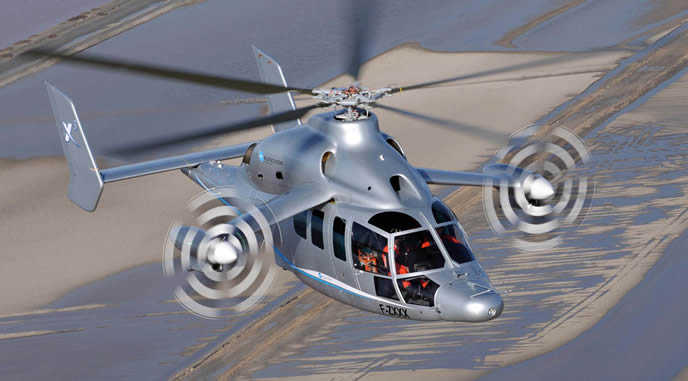
A Hybrid High Speed Helicopter (H3) technology demonstrator developed by Eurocopter began flight testing on September 6, 2010 at the French flight test center at Istres. The new aircraft designated ‘X3’ (X Cube) combines vertical takeoff, landing and hovering performance with high speed cruising capability at speeds exceeding 220 knots. The announcement came less than two weeks after United Technologies (UTX.N) unit Sikorsky claimed an unofficial speed record of 250 knots (460 km/hour) with its X2 prototype .

Almost three months later, on November 29 the X-3 hybrid helicopter reached the initial speed marker flying at a speed of 180 knots, an altitude of 12,500 ft. and performed maneuvers up to 60 degrees angle of bank. Following several months of inspections, Eurocopter will aim for the next target – exceeding the speed of 220 knots, planned for March 2011. By the end of 2011, Eurocopter hopes to be in a position to decide if a program should be launched. If the company will pursue this plan, the hybrid helicopter could be in the market in six years. The concept is aimed at allowing Eurocopter to bring to market a high-speed Super Puma- or Dauphin-sized rotorcraft before the end of the decade. While others are opting to pursue higher speeds, Eurocopter believes 220-230 knots is the sweet spot.
The hybrid helicopter uses the main rotor mainly for lift, with the two propellers replacing the tailrotor. Yaw control is maintained by adjusting the propeller pitch, although the pilot uses the familiar anti-torque pedals. The stub wings take on up to 40% lift at higher speeds, allowing the rotor speed to be reduced. The X3 demonstrator is powered by two turboshaft engines driving a five-blade main rotor system and two propellers installed on short-span stub wings. This configuration combines the speed of a turboprop-powered aircraft and the full hover flight capabilities of a helicopter.
The new concept could be utilized for missions where speed is a determining factor – such as military special operations, long range, long endurance search and rescue, medical evacuation, maritime patrol and border security, passenger transport and inter-city shuttle services.
Initial testing will continue through December with reduced power, progressively opening the flight envelope to speeds of approximately 180 kts. After a three-month upgrade, X3 flights will resume in March 2011 with the goal of reaching sustained cruise speeds in excess of 220 kts.
According to Lutz Bertling, Eurocopter’s President & CEO, the development of the X3 from concept to first flight took less than three years. The X-Cube concept was launched in January 2008, with aim to validate the technical concept of this high speed, hybrid proplusion VTOL system. While the X-Cube takes off and lands like a normal helicopter, during cruising the rotor RPM is reduced, in order to devoid the drag divergence at the tip of the advancing blade. The small wings added to the aircraft partially unload the rotor at high speed, and help avoiding the retreating blade stall. Wing mounted propellers provide the propulsive force in forward flight and anti-torque in hover, thus making the fenestron rotor tail redundant. The development team used elements from several Eurocopter helicopters for the X3, including an AS-365 airframe, the main rotor of an EC-155 and a main gearbox from an EC-175.



















